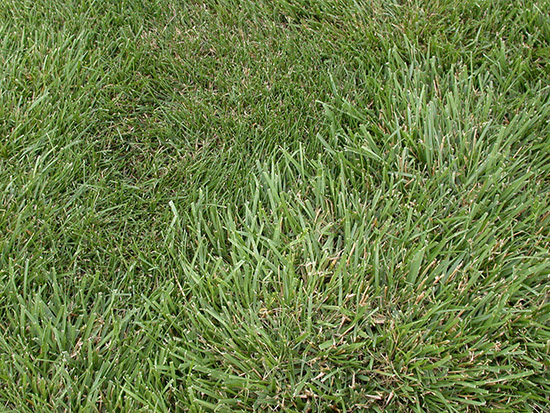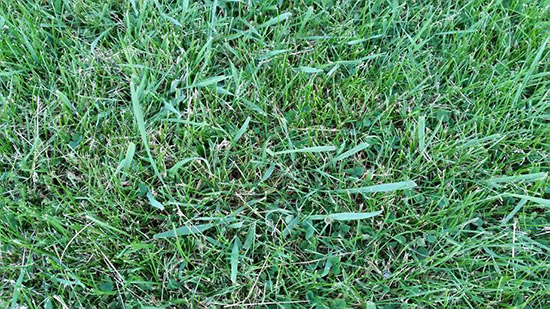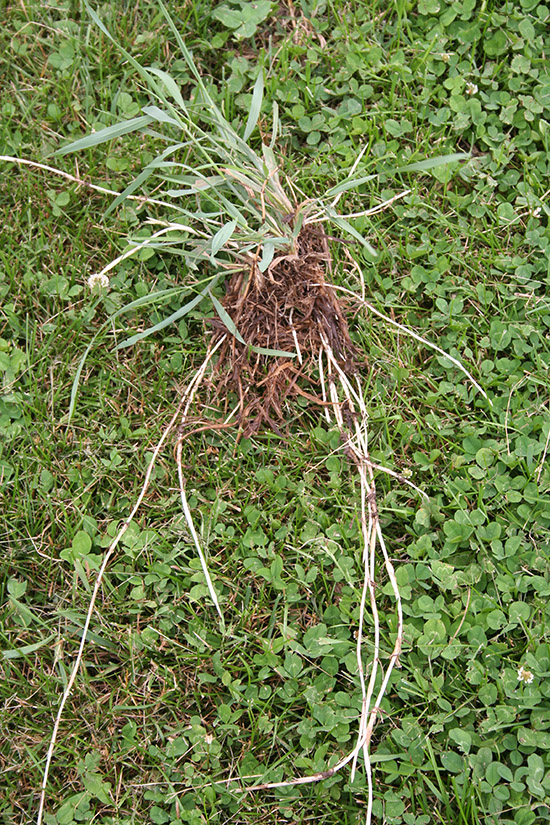Issue 5, May 29, 2018
Cool-Season Perennial Grassy Weeds
I am often asked about controlling quackgrass and tall fescue. These cool-season perennial grasses can be difficult to eliminate from finer-textured, cool-season turfgrasses. Spring is the time of lush new growth for both most Illinois turf, as well as these unwanted grasses. If you haven't done so already, scout your landscapes for these weeds and plan your control tactics. First, let's talk about how to identify these two grassy weeds.
Tall fescue (Schedonorus phoenix [Scop.]) is a clump-forming grass that typically appears as a circular patch that can become wider from tillering. Short rhizomes (underground stems) may be present. The leaf blades are fairly wide. When tall fescue gets mixed in with a slower growing, finer textured turfgrass species, it becomes quite noticeable. Mowing can help to even out the height difference, but tall fescue's lower, light-colored stems and wide, dark green leaf blades that have a glossy lower surface often allow the spots to remain noticeable. Turf-types of tall fescue are often grown as turf.

Tall fescue (photo courtesy of Tom Voigt).

Tall fescue in Kentucky Bluegrass (photo courtesy of Ellen Phillips).
Quackgrass (Elytrigia repens) is rapidly making ground wherever it can be found growing right about now. It spreads by seeds and long, light-colored rhizomes and aggressively forms patches. Young plants can be hairy, which can make it easily confused with crabgrass, but quackgrass growth usually occurs earlier in the spring. To know for sure if what you have is quackgrass, look for the above-mentioned rhizomes and also long, clasping auricles at the base of the leaf; these finger-like projections are key identifiers for quackgrass. Crabgrass develops neither rhizomes nor clasping auricles.

Close-up of quackgrass in a lawn.

Quackgrass rhizomes.
Identifying grasses can be challenging! For assistance, check out Identifying Turf and Weedy Grasses of the Northern United States. This pocket-sized guide is available for sale at: pubsplus.illinois.edu.
Controlling these grasses can be challenging as well. Nonselective products such as glyphosate can be used to control both tall fescue and quackgrass. Multiple applications may be needed and turfgrass will be injured or killed.
Selective products have been available in the past, but have now been removed from the marketplace or the use restrictions on the labels have changed. At one time, turfgrass managers relied on sulfosufuron (Certainty) to control tall fescue growing in other cool-season turfgrasses, but cool-season grasses were removed from the label a few years ago. Any existing old stocks can still be used however. This winter, I discovered several discussions online where turfgrass applicators were suggesting that sulfosulfuron could perhaps still be used with a very loose interpretation of the label. I have cautioned applicators against this for fear that IDA inspectors would not share the loose interpretation. These applications are presumably broadcast in nature. However, it MAY be possible to use sulfosuron as a spot treatment. Applicators should carefully read and follow all label directions!
Also for tall fescue control, existing stocks of Corsair (chlorsulfuron) can be used. Additionally, this active ingredient, chlorsulfuron, is found in Telar XP and Chlorsulfuron 75DF which are used in industrial sites and roadsides, but not in managed turf areas. Purdue University recommendations mention spot treatments of these products. Could this be another loose interpretation of labels? Perhaps. Another consideration is that if you are going to spot treat anyway, it would likely cost less to use glyphosate than chlorsulfuron as there are many generic formulations of glyphosate in the marketplace.
Some applicators have mentioned that they have seen some control of quackgrass with mesotione (Tenacity) while controlling other grassy weeds such as nimblewill. Quackgrass is not listed on the product label. I trust that Syngenta tested their product on quackgrass but the level of control was not great enough to warrant label inclusion. Tenacity is safe for use on tall fescue meaning that it will not harm this plant. (Michelle Wiesbrook)
Author:
Michelle Wiesbrook